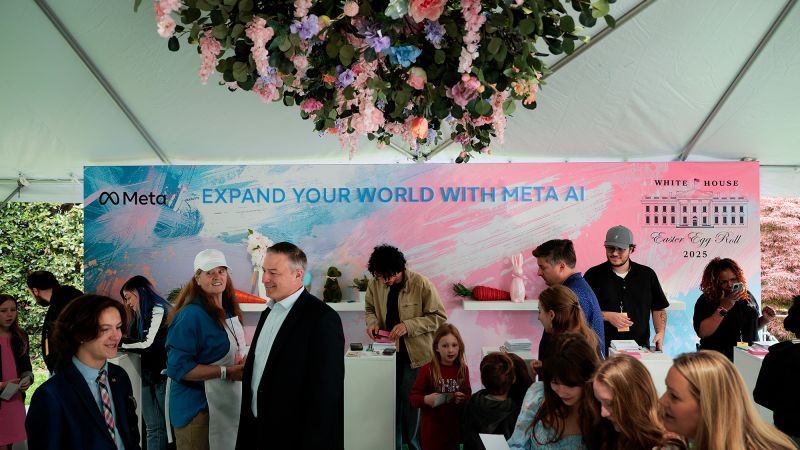The recent White House Easter Egg Roll sparked a significant intersection of public celebration and corporate branding, presenting a scene seldom witnessed on the historic grounds of the presidential estate. Held on a Monday, the event was accompanied by a dazzling display of logos from major tech firms and relevant associations, introducing an unprecedented element of commercialism to a traditionally family-oriented occasion. Many attendees observed this shift with mixed feelings, as the event, designed as a fun-filled day for children and families, now featured corporate sponsorship, raising questions regarding the ethics of such activities.
As the nostalgic tunes of Martha and the Vandellas’ hit “Nowhere to Run, Nowhere to Hide” filled the air, children could be spotted dancing joyfully on the lawn. The well-known military band performed against a vibrant backdrop reminiscent of Easter, with colorful eggs and playful rabbits, one adorned with the recognizable YouTube logo. Lines formed in front of Meta’s tent, where families eagerly awaited a chance to snap photographs in front of a White House-themed backdrop, stylishly integrated with a locator icon mimicking Instagram’s design. This new blend of social media branding alongside traditional family festivities marked a noteworthy transition in how public events are being perceived and executed.
However, the sponsorships associated with this year’s event have raised eyebrows among ethics experts and legal commentators, alongside officials from various political affiliations within the White House. Concerns have emerged regarding solicitation practices that appear to contravene established regulations barring the use of government resources for personal gain. With all funds raised from the sponsorship activities designated for the nonprofit organization, the White House Historical Association, the question remains whether business promotion should play such a visible role in presidential events.
The sponsorship opportunities advertised were notably expansive, including offerings such as “naming rights for key areas or elements,” as well as visibility for sponsor logos on event signage. These details stemmed from insights provided by Harbinger, an external production entity involved in arranging the event. Such corporate sponsorship not only highlights the efforts businesses are willing to undertake to forge stronger alliances with the administration but also reflects the broader implications of commercial influence in public affairs.
The interplay of corporate interests and political events reached a poignant moment when amidst the festive atmosphere, a volunteer donned in a white apron facilitated a photo opportunity for a young child and their family, who rang a mock bell sponsored by the New York Stock Exchange while the financial markets experienced a downturn of over a thousand points. Such imagery poignantly captured the simultaneous celebration and tension that can arise from commercial enterprise intertwining with governmental functions.
The event also featured an arch adorned with hundreds of fresh carrots bearing the branding of the “International Fresh Produce Association” as families strolled through. Additionally, the presence of The Toy Association being represented through play areas filled with Slinky toys emphasized the growing presence of commercial branding aimed at capturing the attention of young children and their families. A “reading nook” tent furnished with a couch and Amazon branding further showcased corporate influences embedded deep within the festivities.
In stark contrast, when First Lady Melania Trump took to reading the story “Bunny with a Big Heart,” she deliberately distanced herself from the corporate atmosphere by setting up in a different, more serene reading nook located in the Jacqueline Kennedy Garden. This area was adorned with beautiful floral arrangements and a pastel-colored sign symbolizing the annual Easter Egg Roll, reflecting a more traditional aspect of the event, contrasting sharply with the commercial zeal elsewhere in the festivities.
According to reports from a source familiar with the planning, private contributions reportedly covered all essential aspects such as activity booths, entertainment, and decorations. This funding structure also included provisions for any surplus finances, which the source indicated would be allocated to similar White House gatherings that follow, such as Halloween festivities and Independence Day celebrations. The complex dynamics at play showcase how the White House Easter Egg Roll has evolved into a platform reflecting contemporary intersections of public life, corporate interests, and family-oriented community engagement.



